
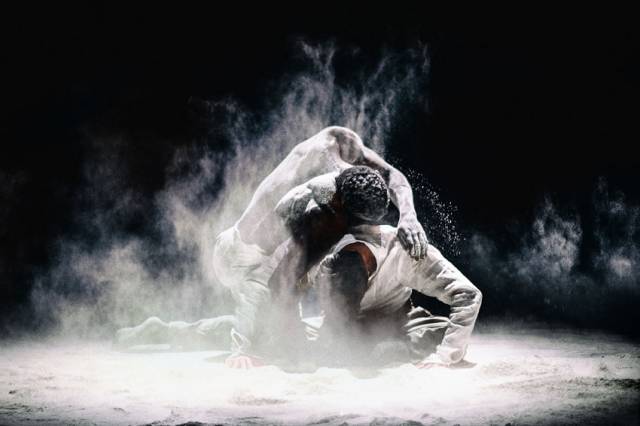
As with all art, dance has long been a vehicle for political and social expression and commentary. And in times when we most need a voice to speak to and a mirror to reflect upon our own existences, we look to our artists. Paul Lightfoot, Artistic Director and Resident Choreographer of Nederlands Dans Theater (NDT), has dedicated his career to expressing the human condition with poignant and progressive dance-theater works. Along with long-time collaborator Sol León (NDT Artistic Advisor), Lightfoot has come from a long line of innovative choreographers at NDT and himself danced with the company beginning in 1985. León and Lightfoot have been choreographing thoughtful and striking works since 1989 and are proud to present the US premieres of Safe as Houses and Stop-Motion at New York City Center, November 16-19, with works by NDT associate choreographers, Marco Geocke and Crystal Pite.
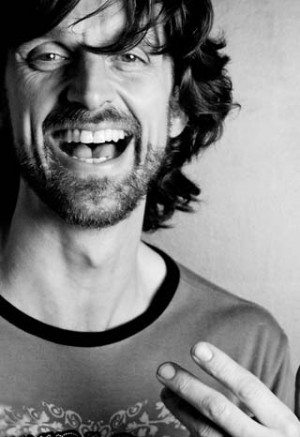 I’m interested in hearing about how you selected the four works you are presenting within the upcoming program at New York City Center.
I’m interested in hearing about how you selected the four works you are presenting within the upcoming program at New York City Center.
It’s going to be a wonderful moment for the company to be back in the city. The company has such a history in New York City so it’s really a thrill to bring the works [here], which sort of comes to the program choice. The idea about the program is [to bring] as much of [our] voices as possible in one evening with works that are diverse yet connected.
We open the evening with Safe as Houses, which we created quite a long time ago now for NDT. That was in 2001 [and] just a few months after 9/11, actually. When we made this piece, a lot of people in the industry were saying, “Oh! This is your response. This is your response to the tragedy that occurred in the city.” It was not, directly. But we did carry (of course) so many of the feelings that were [felt] at that time. Safe as Houses, as the title implies, is a little bit about: nothing is for sure in life… in the world. It’s up to the environment we live in. Sol was very much inspired by the works of the I Tjing. We created a décor, you could say a theatrical space, that also dealt with these ideas of the Book of Changes. The idea is that the stage is never still; it’s constantly altering its form. Therefore, the world around it must also go with it. We created this in 2001, so it very much has a link to the environment, to the world that we live in.
That goes very much for the final work, Stop-Motion. In many ways, it’s a piece about transformation. We do use the space; we use the stage -- we literally take it apart during the work so the audience is left to see the bare walls of the building. You can actually realize that this place… the cathedral of our work is the place where we finish our artistic journeys. It becomes very much a sacred heart for us. This is important in the work because [it’s about] transformation and the destruction of environment in many ways, and the nobility of the human soul that carries on. It’s quite a melancholic work and a very beautiful [work] that highlights the cast. It’s really an honor to the people in the company and all those international, cultural stories that gather in one voice as a company.
Marco Goecke’s work, Woke up Blind, is set to Jeff Buckley’s music. It premiered just over a half a year ago and has struck such as chord with us all -- the performers and the audience. And I really wanted to bring it to the states. [Buckley’s] music is so iconic and his short life somehow meant so much to so many people who followed his music, his artform. That was the same for Marco; it’s really like a pure interpretation of the two songs he uses from Jeff Buckley. Marco’s body language is extremely eclectic. He really uses the speed of the body. It’s almost as if you can’t keep it relative to time. There’s such a speed behind his physicality, using very much the torso and the arms and the head. [It’s] very focused work, extremely complex, and takes a lot of focus from the seven performers in it. I think it’s a jewel of a piece and quite [matching] the virtuosity of the group.
That leads almost immediately into the work from Crystal Pite, which is a really, really interesting one. It’s a work (a play) that she conceived and wrote with playwright Jonathan Young. And she makes a physical narrative out of this play called The Statement, referring (in a satirical way) to what’s going on in the world and who is taking care of it -- who’s taking responsibility and who’s being blamed. It’s very relevant to all of us in lots of ways. It seems to be very humorous but has a very dark undertone. You realize there is a wise choreographic insight going on. It’s not physical theater; it is really dance. It’s hard to understand when you hear it described as a play… I would say it’s a physical narrative and absolute genius.
Hopefully you can get an idea of the whole evening -- every time the curtain opens, it’s like you’re watching a different world and company almost, because the styles between the choreographies are so diverse. But at the same time, that really is the nature of the company and what we wanted to show. We wanted to show how we can have that chameleonic kind of feeling, at the same time keep one voice.
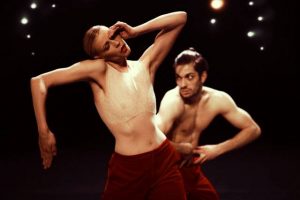
In an interview earlier this year, you mentioned a joking reference to NDT as a “mini United Nations” and you went on to say that you hope this joke is taken more seriously: that if we can do this in the arts why can’t we do this in the world?
You know, I’m Brexit-ish. Imagine what I’ve gone through this year seeing a country that I’ve called my home so many times somehow having forgotten what happened less than two generations ago when the world war [erupted] and how important it is to embrace other cultures -- [that they] not feel that they’re threatened. They are [groups] to learn from. And of course there are many arguments behind all of it and it isn’t so simple. But I do think that culture and art in general often get snubbed by the people above as having perhaps any real relevance in our lives. I think it’s such a mistake, and I think it’s a responsibility that artists have to try and remind the world that things like this can be possible… that we can live together. That’s what we do. Art should respect the world and its possibilities.
The very nature of the company does have that feeling to it; we’re all aliens and foreign in that entity -- there’s no one nationality. And that to me is very Dutch. I can’t imagine (and I’m sorry to say it) that there are very many countries where companies like NDT could exist. For many countries, it would almost be that they would feel that undermining their culture or their national pride. Whereas you see with the Dutch that have such a broad mind themselves -- they’re learners; they’re always curious; they’re not so forceful with their own opinions; they like to hear from others and get straightforward answers. And that’s the way the Dutch. That’s such a tolerance and open-mindedness that has really enabled the company to be what it is… what it needed to be. If a company like ours (let’s be cruel about it) was in America, or I would say even in Great Britain, it would be a very difficult thing to do because there would be stipulations and questions that I think are unnecessary. I’m very proud to [be a part of] Netherlands Dance Theater. And I don’t say it arrogantly, but I do take it seriously. I think we all do; everyone is looking at the world at the moment, wondering how mad it really is.
What I really enjoy and respect about your work, and NDT in its history, is the deep-seated intention that comes often from raw human emotion and experience. How do you continue to find inspiration and communicate that so powerfully year after year?
The point is: you must have something to say. Even if it’s not true; even if it’s bullshit… you must have a reason. When you don’t have that reason, then you’re lost -- you fail. For dance theater, it’s hard. It isn’t always cute. But it takes that risk to not live by a recipe, to be a river [and] give that chance for things to move. It’s a very vulnerable position you put yourself in. [For] a true artist, however abstract they are, there’s no way that they can’t insert something of themselves in their work. That’s what I feel I do. When I don’t quite know what I’m saying, I’m very honest about it. And that gives you some room… you will find it. But you must find that reason, because I’m afraid otherwise dance does become something very superficial, pretty, and kind, and entertaining. And I think it should be all of those things, but it should also be challenging and reminding. It has to remark on the world in order to have real value.
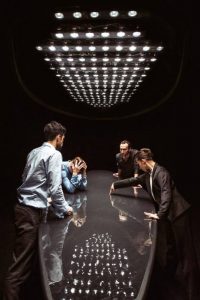
How has your figurative language changed or evolved over the years?
Sol and I have both been for three decades now at NDT, so you could say we’re genetically bred through the genius of Jiři Kylián but also many other [predecessors]. They all taught Sol and I the same thing without saying anything. They forged themselves a choreographic language; they worked hard on the content. [With] that content, then they were free to basically say anything. We’ve had fantastic opportunities that I’m always grateful for. But also, it was hard [working] under the shadow of these great wings. Sol and I, in a practical sense, said if we’re going to survive, we’re going to have to work hard on doing that ourselves -- and we did feel we had something to say. We started with our body, with our physical language. And of course we had influences, and I’m very proud of them all. We did take their influence and we did work hard. We did have our own thoughts and our own skin and bones.
I’m a left-handed person -- I’m extremely left-handed (laughs). There’s something a little bit uncoordinated. I would make stuff and set it on people… and it looked so awkward in the beginning, very strange coordination. But once they get used to it, and once we work through that, there was something very developed in there and something very individual. Over the years, you’re connecting more and more, perhaps with the same people and developing your relationships. And we talk less and less and you realize we can share quite easily.
We went from very, very bizarre physical movement in the beginning and then we sort of let that go a little bit and let that breathe a little bit more… [made it] a bit more elegant. Then, we went through a very abstract period with our bodies where we were really working hard on, particularly with pas de deuxs, on how we could create this new aesthetic where two people were intensely involved but without overusing the physicality. It is constantly changing. I, for instance, am a big lover of pas de deux work. There aren’t many guys left who really enjoy partnering and take it on. For me, it was always something that fed my career as a dancer. I was an easy partner and I didn’t enjoy solo work. Even now, 30 years later, I’ll always be making some parts of the pas de deuxs that we do in the works. I need to keep that contact with the physic of the work.
Sol is exactly the same in a very different way. That’s what’s nice about our work. There’s the two of us there, however much struggle that brings, the pair of us have something to say… the work is a dialogue. Sometimes it’s difficult, the dialogue. But it always has purpose and as long as we respect each other.
It’s so rare and beautiful to be working with someone for so long…
It comes with a price tag, but it’s fantastic. She’s an amazing person: super intense, very clear. Whereas I sort of dream my way around things, she’s very grounded. That’s beautiful to experience and at the same time I think we both give each other treason and a certain amount of support. Over the years, we actually talk better less. I think that’s a very positive thing; we don’t have to sit and talk it all through. We know each other well enough -- when is the time to step in; is it going alright; can I help you here; or do you want me to just step away? That isn’t something negative. It’s very, very beautiful. It takes time, just like any other relationship.
I always laugh at people because they [ask], “What’s it like?” And I say, “Well… have you ever tried to make dinner with your partner in the kitchen? That’s what it’s like.”
(Laughs) That doesn’t happen in my kitchen.
(Laughs) Lots of people can understand -- just think of any relationship. Although Sol and I are not together anymore, we’ve never been closer in many ways too. [I] have to say it: she’s my inspiration in lots of ways. People see us and they are like, “My god! You’re still so attached to each other for a couple who broke up… that’s very weird.” But our work has always been very important to us, and that fact doesn’t change. And lots of our years of our lives went into that, and it isn’t something I feel sorry about. It’s a wonderful time.
That’s beautiful.
Well, not always...
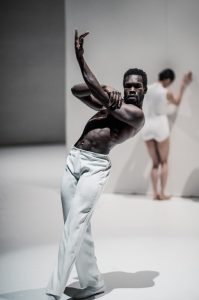
You’ve already been working together for 25 years. How do you see your relationship and your work progress over the next 25?
We definitely don’t live by any recipe, and I’m a dreadful planner, which is an awful thing to admit when you’re meant to be an artistic director. But I don’t look too far ahead. For my personality, it concerns me, shall I say, when I have to look too far ahead, and simulate and understand what’s coming. You could write it all down and structure it all out in a big Excel sheet, but I tell you what: you know it’s not going to happen that way. You could say that’s very much the way NDT functions as well: we work very hard to make a structure to things, but we’re all willing to change it in a minute. That has been the case sometimes. You all just turn on your heels, and it’s a frightening moment. But it’s also so uplifting to feel you still have that potential, that you can say: “You know what, fuck it. We’re not going to do this, we’re going to do this because this is the right thing to do.” That takes balls sometimes, and it’s very hard in the arts world. So much is dictated by the wrong influences, [namely] fear. Fear is a big danger in art. We try not to be concerned with those things, [even though] sometimes it feels like you have to.
Well, I’m very eager to see this program you’re bringing to New York. Is there anything specific about performing here that you’re looking forward to?
We’ll be starting in Canada, so by the time we get to New York, we’ll be really juicy. You know how it is, every show is important, but coming to New York, it will be really, really thrilling. Because we have some time before the performances, we’ll be doing a presentation at the Guggenheim, explaining who we are and what we do. We’ll also be doing something at the Met museum. I’m really excited because both of those museums are so iconic. And I’m a big architecture fan, so I love to just walk. Walking is great and seeing all of the crazy people -- this city is full of crazy people (laughs). I think about all those people who must have been building these old skyscrapers years back and how that looked for all these people. It must have been a crazy time. It’s a very iconic city; I don’t say it’s the best city in the world, but I think it’s one of the first seriously original.
But, it’s also an exhausting place. I must be honest, I’m very much a country man, so these big cities, I’m absolutely enthralled to visit them, but it can also be very draining. The bigger and more bustling the city, the more I tend to nussle down a little bit and keep my breath. I think it’s very easy to get lost in the hype and vibe of this place. It’s very true that this city never sleeps -- for me, as an insomniac, that’s a very dangerous place to be (laughs). But I do love to walk. I love to wake up very early in the morning and walk… see the city in all it’s beauty, because it really is an exceptional place.
Nederlands Dans Theater will perform at New York City Center from November 16-19.